#Robert Niese
Photo

Bohemian Waxwing (Bombycilla garrulus) Bombycillidae
Missoula, MT
April 18, 2017
Robert Niese
In early April, waxwings were migrating through town in the thousands. They paused in freshly blooming trees to gorge on buds and, in this case, last year’s fruits before continuing their trek northward. The noise and mess they created was astounding! I loved waking up to the roar of their high pitched calls. This flock consisted of around 600 Bohemian Waxwings and a few dozen Cedar Waxwings. The easiest way to tell them apart (for me, at least) is by their vent and under-tail colors. Bohemians have a rufous under-tail and a gray vent while Cedars have a gray-white under-tail and a pale yellow vent.
#Bohemian Waxwing#waxwings#Bombycilla garrulus#Bombycilla#Bombycillidae#birds#Aves#Missoula#Montana#Pacific Northwest#natural history#original photography#photographers on tumblr#Robert Niese
314 notes
·
View notes
Text
LUCY AND ALADDIN’S LAMP
S3;E21 ~ February 1, 1971

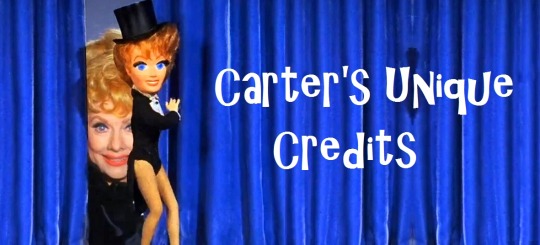
Directed by Charles Walters ~ Written by Frank Gill Jr. and Vin Bogert
Synopsis
When Lucy holds a garage sale, she discovers an old lamp. When wishes start to become reality Lucy believes the lamp may posses magic, until she loses it hiding it from Harry.
Regular Cast
Lucille Ball (Lucy Carter), Gale Gordon (Harrison Otis Carter), Lucie Arnaz (Kim Carter), Desi Arnaz Jr. (Craig Carter)
Guest Cast

Mary Jane Croft (Mary Jane) played Betty Ramsey during season six of “I Love Lucy.” She also played Cynthia Harcourt in “Lucy is Envious” (ILL S3;E23) and Evelyn Bigsby in “Return Home from Europe” (ILL S5;E26). She played Audrey Simmons on “The Lucy Show” but when Lucy Carmichael moved to California, she played Mary Jane Lewis, the actor’s married name and the same one she uses on all 31 of her episodes of “Here’s Lucy. Her final acting credit was playing Midge Bowser on “Lucy Calls the President” (1977). She died in 1999 at the age of 83.

George Niese (Mr. Frost) previously appeared in “Lucy Becomes a Father” (TLS S3;E9). This is his only episode of “Here’s Lucy.”

Robert Foulk (Janitor) played the policeman on the Brooklyn subway platform in “Lucy and the Loving Cup” (ILL S6;E12) and a Los Angeles Detective in “Lucy Goes To A Hollywood Premiere” (TLS S4;E20). This is the third of his six characters on “Here’s Lucy.”
This is Foulk's third episode in a row on the series.

William Lanteau (Mr. Minkle) first appeared with Lucille Ball in The Facts of Life (1960). In addition to an episode of “The Lucy Show,” Lanteau did four episodes of “Here’s Lucy.” He is best remembered for playing Charlie the Mailman in the play and the film On Golden Pond (1981).
Mr. Minkle is the superintendent of the office building where Harry and Lucy work.
The Telegram Delivery Boy is uncredited and has no lines.

Some reports say this episode was filmed on April 6, 1970, ten months before its initial air date. However, that is a Monday, and most all episodes were filmed on Thursday or Friday after four days rehearsal, so this is unlikely.
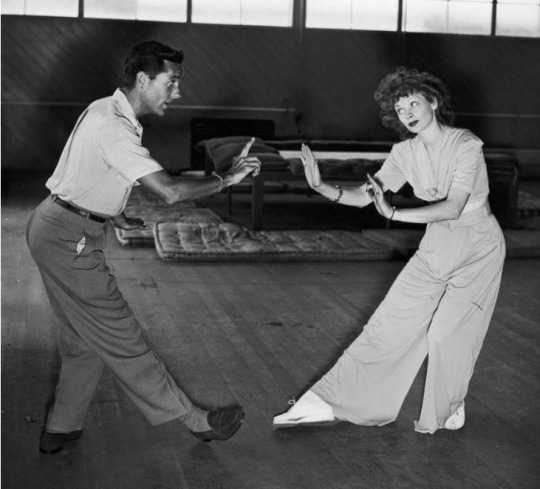
This is the second of only two episodes directed by 1954 Oscar-winner Charles Walters. The previous entry was “Lucy’s House Guest, Harry” (S3;E20). He went on to direct two of the Lucille Ball Specials: “What Now, Catherine Curtis?” (1976) and “Three for Two” (1975). From 1942 to 1945, Walters served as dance director on six films starring Lucille Ball. This episode is mentioned in the biography Charles Walters: The Director Who Made Hollywood Dance by Brent Phillips.
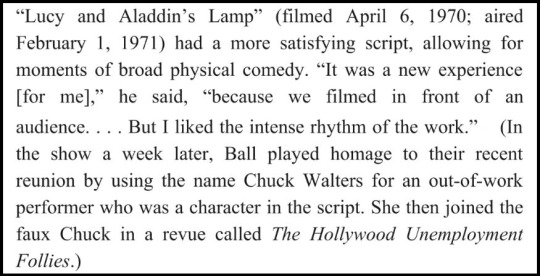
Likewise, this was the second and final episode written by 1955 Emmy-winner Vin Bogert. The first was “Lucy Stops a Marriage” (S3;E16), which he also co-wrote with Frank Gill Jr. It was a posthumous credit for Gill, who died six months earlier. It was the penultimate screenwriting credit for Bogert, who died in 1978.
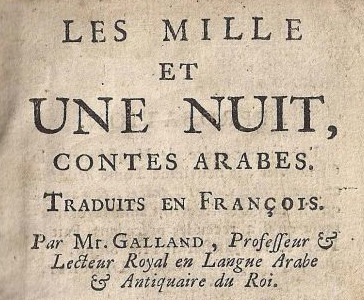
The title refers to the Middle Eastern folk tale of the boy Aladdin and a genie that comes from a lamp to grant him three wishes. It is one of the tales in The Book of One Thousand and One Nights ("The Arabian Nights"), and one of the best known - although it was not part of the original Arabic text, but was added in the 18th century by Frenchman Antoine Galland. The story has been the basis for many screen and stage re-tellings, including the current Disney musical Aladdin.
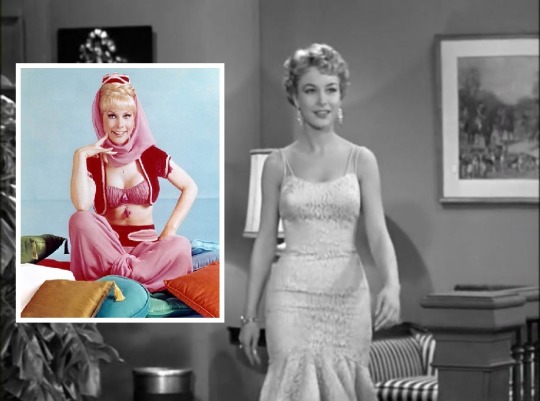
Another television sitcom was based on the legend of Aladdin: “I Dream of Jeannie” (1965-70), which had just ended its long run on NBC. It starred Barbara Eden as the genie named Jeannie, who lived in a bottle rather than a lamp. Barbara Eden made her TV debut on “I Love Lucy.” Hayden Rorke, who played the long-suffering Dr. Bellows on the series, also did an episode of “I Love Lucy” and recently appeared on “Here’s Lucy” as a Judge.

In the first scene, Craig is wearing a top hat with a flower in it. The other actors (Mary Jane Croft and George Niese) seem a bit taken aback by it.
MARY JANE: “Oh! I like your hat. (under her breath) Bless your heart.”
MR. FROST: (Points at the hat, surprised) “Oh! Oh ho ho ho.”
Perhaps it is something Desi Jr. saw in the props pulled for the scene and took a liking to? It also many have some sentimental significance to the actor, but for such a visual statement, it does not figure into the plot, which is unusual.

At the start of the episode, Kim is holding a heart-shaped throw cushion that may be a tribute to the opening credits of “I Love Lucy.”

Lucy gets a Western Union telegram from the (fictional) Murphy Soup Company to tell her she’s won a contest.

Lucy's prize-winning soup jingle is to the tune of “Jingle Bells,” a song that was heard many times on “I Love Lucy.”

Aside from Ann-Margret, Craig would wish for two tickets to the sold-our Rams Football game. After a dramatic thunder clap, Craig gets a call from his friend Alan who offers him a ticket. Craig says “How sweet it is!” Sex symbol and singing sensation Ann-Margret charmed Craig in a season 2 episode of “Here's Lucy.” The Los Angeles Rams would have been the Carters' hometown football team. “How sweet it is” was the catch phrase of actor / comedian Jackie Gleason (“The Honeymooners”), who made a cameo appearance in the second episode of the series.

Craig reads the October 1968 issue of McCall's with English actress Samantha Eggar on the cover. In “Ricky Has Labor Pains” (ILL S2;E14), pregnant Lucy Ricardo is reading the January 1953 McCall’s, which clearly has a cover that says “Why I Love Lucy” by Desi Arnaz.
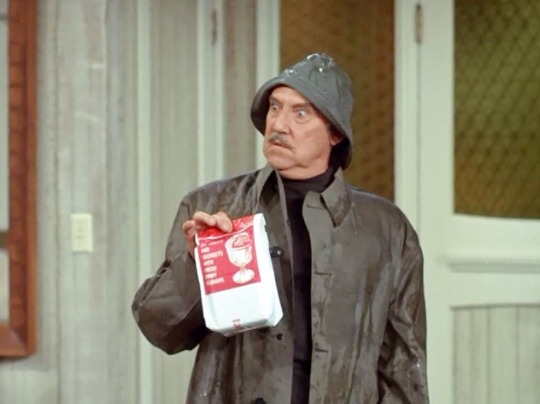
Kim wishes for Jamoca Almond Fudge Ice Cream, her favorite. After a dramatic thunder clap, Uncle Harry promptly arrives at the door to deliver it! Jamoca Almond Fudge is a signature flavor of Baskin-Robbins, who first marketed it in 1959. It is made by combining Jamoca coffee ice cream with roasted almonds and a chocolate ribbon. The bag Harry is holding, however, is not branded with their logo: pink and brown polka dots encircling a large number 31, the number of flavors they offer.

The second scene opens with Harry and Lucy coming to work with a happy Harry (dreaming of great wealth if he got access to the lamp) paraphrasing Robert Browning’s verse drama Pippa Passes (1841). The original goes:
The lark's on the wing;
The snail's on the thorn:
God's in his heaven -
All's right with the world! — from Act I: Morning
Harry’s version replaces mention of larks and snails with “The sun is shining; the birds are singing” and omits any reference to the Deity altogether.
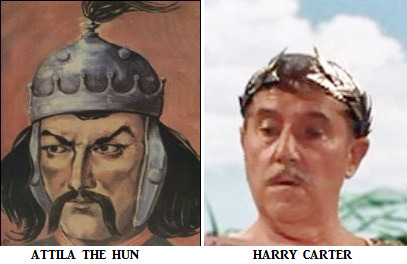
When Lucy won’t let Harry make any monetary wishes on her lamp, he storms off pouting and Lucy calls him Attila the Hun. Attila the Hun, was the ruler of the Huns from 434 until his death in March 453. During his reign, he was one of the most feared enemies of the Roman Empire.

Mary Jane tells Lucy that there's a sale on Italian knits at Morton's Department Store. Morton is Lucille Ball's married name since her marriage to Gary Morton (nee Goldaper) in 1961. Gary Morton is also a producer on “Here’s Lucy.” The fictional Morton’s Department Store joins Morton’s Service Station, Morton Pictures, and a number of other businesses named Morton on the series!

The janitor comes to empty the waste paper baskets idly singing “When Irish Eyes Are Smiling.” The song was written by Chauncey Olcott, George Graff Jr., and Ernest Ball in 1912. It was sung by William Frawley (Fred Mertz) in the 1936 film It's A Great Life! and was heard on “I Love Lucy” in “The Star Upstairs” (ILL S4;E25).
Harry says the Unique Employment Agency is located in office #1506. This implies that they are on the 15th floor.
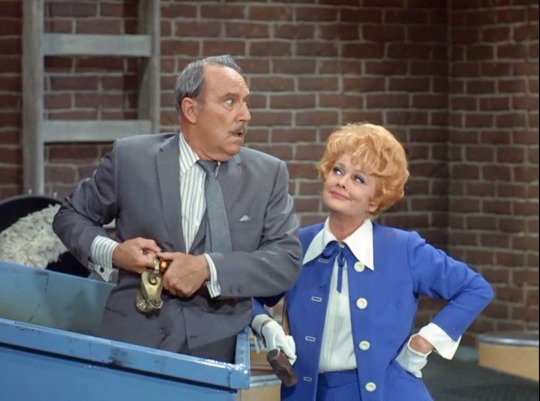
Finally finding the bottle in a dumpster, there is just one thing preventing Lucy from getting it back: a glass bottle! Preparing himself for Lucy to hit his finger with a hammer to get a bottle off it, he says “If John Wayne can do it, so can I.” John Wayne appeared with Lucille Ball as himself on “I Love Lucy” and “The Lucy Show.” Both episodes were titled “Lucy Meets John Wayne.”
At the end of the episode, Craig reveals that the lamp is just a novelty store item manufactured in Pittsburgh. A disappointed Lucy corrects him.

The Mexican border city was the location of “Lucy and Viv Visit Tijuana” (S2;E19) aired a year earlier.
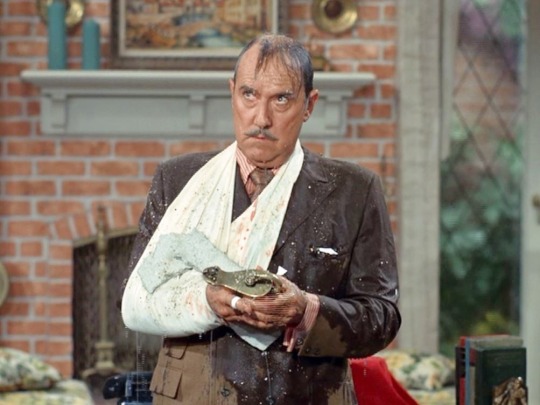
It wouldn’t be “Here’s Lucy” if Gale Gordon didn’t get wet!
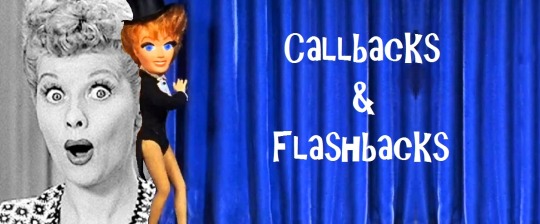
Garage Sale Treasures!

Hanging above the steamer trunk is Lucy Ricardo's iconic blue polka dot dress from “I Love Lucy.” It was designed by Elois Jensen and was seen in many episodes of the series.

Next to the blue dress is an art deco poster of Sarah Bernhardt by Alphonse Mucha (1897). The poster was previously seen in the dorm room in “Lucy, the Co-Ed” (S3;E6) and in the studio of the knife thrower in “Lucy, the Cement Worker” (S2;E10).

The zebra lamp with the red shade was on the tables of the Red Devil nightclub “Lucy and Ma Parker” (S3;E15, left). Unboxing items for the garage sale, Lucie finds her favorite doll, Clarabelle. Clarabelle made an appearance in “Lucy, the Part-Time Wife” (S3;14), although she now has on a new frock.
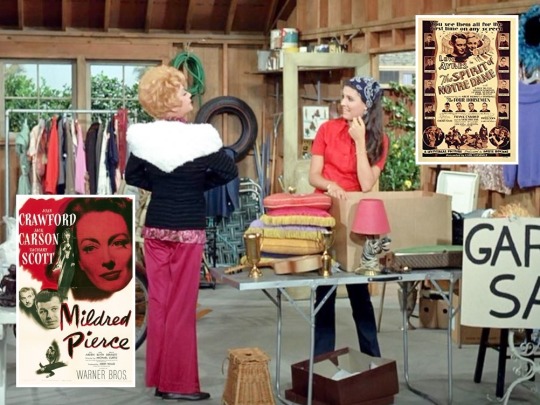
Lucy pulls out a fur-lined jacket she says was worn by Joan Crawford in Mildred Pierce. The 1945 film won Crawford an Academy Award. Joan Crawford guest starred on “The Lucy Show” in “Lucy and the Lost Star” (TLS S6;E22). Craig says that judging by the shoulder pads she could have worn it in The Spirit of Notre Dame. Craig is referring to a 1931 football-themed movie starring Lew Ayres.
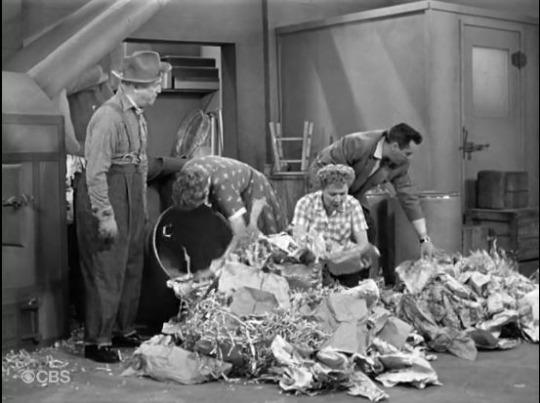
Search through the building’s trash for the lamp instantly brings to mind when the Ricardo’s and Mertz’s searched through the trash of 623 East 68th Street to find the pieces of Lucy’s torn-up roman a clef in “Lucy Writes a Novel” (ILL S3;E24).

Lucy and Harry were also up to their necks in trash in “Lucy the Process Server” (S1;E3) - this time in a department store basement - searching for an envelope of cash.

Leaky ceilings in need of plastering was also a plot point in two episodes of “The Lucy Show”: “Lucy and Viv Put in a Shower” (TLS ) and “A Loophole in the Lease” (TLS S2;E12). Both times the leaks were caused by overflowing tubs and showers, but here the cause is the continual rainfall.

Sound vibrations and not water was the cause of the ceiling collapse that ended “Breaking the Lease” (ILL S1;E18).
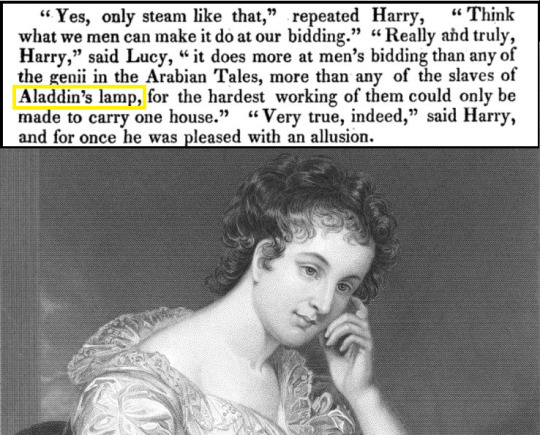
Flashing way back to 1813, prolific novelist Maria Edgeworth (1768-1849) penned a children’s book titled Harry and Lucy. In it, they marvel at the power of steam bursting through a kettle spout, comparing it to the magic of Aladdin’s Lamp. Not only did Edgeworth foresee the era of the steam-powered engine, she may have foretold “Here’s Lucy” as well!


Do You Live in a Barn? His arm in a sling, carrying an umbrella, and taking off his hat, Gale Gordon is unable to properly shut the front door, despite the fact it is pouring rain outside. Lucille Ball’s eyes dart over at it, doubtless wondering if she had time to close it without spoiling the take. She doesn’t - and it stays open for the rest of the scene.

Where the Floor Ends! When the hole in the ceiling breaks open, the camera is back too far and viewers can see where the carpet ends and the stage floor begins.
Sitcom Logic Alert! Only Lucy would find a miraculous lamp that grants wishes and hide it in a trash can in order to go on a shopping trip for discount sweaters!

“Lucy and Aladdin’s Lamp” rates 4 Paper Hearts out of 5
A fun episode that straddles the reality / fantasy line effectively. The Easter eggs in the garage sale scene are a treat for Lucy lovers!
#Here's Lucy#Lucille Ball#Gale Gordon#Lucie Arnaz#Desi Arnaz Jr.#Mary Jane Croft#Charles Walters#Vin Bogert#Frank GIll Jr.#George Niese#Robert Foulk#William Lanteau#Aladdin#Aladdin's Lamp#Garage Sale#Sarah Bernhardt#I Love Lucy#Mildred Pierce#Joan Crawford#McCalls#Ann-Margret#LA Rams#Jackie Gleason#Morton#John Wayne#CBS#TV#1971#The Spirit of Notre Dame#When Irish Eyes Are Smiling
5 notes
·
View notes
Text
Netzfund:
Ich höre gerne auf Virologen und Fachleute,die sachlich bleiben.
Zum Beispiel auf:
Prof. Dr. Dr. Martin Haditsch,
Prof. Dr. Carsten Scheller,
Prof. Dr. Klaus Püschel,
Prof. Dr. Sucharit Bhakdi,
Prof. Dr. Stefan Hockertz,
Prof. Dr. Jochen A. Werner,
Prof. Dr. John lonannidis,
Prof. Dr. Yoram Lass,
Prof. Dr. Pietro Vernazza,
Prof. Dr. Knut Wittkowski,
Prof. Dr. Gérard Krause,
Prof. Peter Gøtzsche,
Prof. Jay Bhattacharya,
Prof. Erich Bendavid,
Prof. Hendrik Streek,
Prof. Karin Mölling,
Prof. Maria Rita Gismondo,
Prof. Frank Ulrich Montgomery,
Dr. Jaroslav Belsky,
Dr. Bodo Schiffmann,
Dr. Joel Kettner,
Dr. Wolfgang Wodarg,
Dr. Mark Fidigge,
Dr. Karl J. Probst,
Dr. Jenö Ebert,
Dr. Yanis Roussel,
Dr. David Katz,
Dr. Michael T. Osterholm.
Außerdem noch auf die Studie des MIT, Stanford und Heinsberg,die alle gemeinsam die Letalität von Covid-19 bei ca. 0,3% einordnen und sie damit im Bereich einer Influenza A liegt.
Wem ich nicht so glaube:
Dem Tierarzt Dr. Wieler vom RKI
Dem Unwissenschaftler/Hobby-Hysteriker Dr. Drosten, der wie bei den letzten "Pandemien" (Vogelgrippe, SARS, Schweinegrippe und Kamelhusten), im Gegensatz zu Wordag und Bhakdi, immer vollkommen daneben lag.
Fachmänner von dem unser Hypochonder Drosten noch viel lernen kann, rhetorisch sowie fachlich, ganz ohne Panikmache, sachlich und ohne Weltuntergangsphantasien.
Ich bin gebildet genug, um die Zahlen des Robert-Koch-Instituts zu interpretieren, wonach derzeit die Wahrscheinlichkeit, eine infektiöse Person überhaupt zu treffen, nahe null ist.
Ich lasse mich nicht von den "dramatisch" steigenden Zahlen der positiven PCR-Tests manipulieren, sondern setze diese Zahlen in Relation zu den durchgeführten Tests, die in letzter Zeit deutlich gestiegen sind, während der Anteil der dort positiv getesteten Personen weiterhin deutlich unter 1% ist.
Ich habe nachvollzogen und verstanden, wie der R-Wert berechnet wird. Allein durch eine gestiegene Anzahl Testungen kann er beliebig manipuliert werden, ohne dass der Anteil der positiv Getesteten tatsächlich steigen würde.
Ich deute die Maskenpflicht als bewusste Aufrechterhaltung der Angst - tagtäglich soll jeder das Gefühl der permanenten Gefahr sehen, auch wenn sie real nicht existiert.
Ich weiß, dass die Wahrscheinlichkeit einer präsymptomatischen oder asymptomatischen Ansteckung äußert gering ist - falls sie überhaupt existiert.
Ich habe mich nicht nur in den Mainstream-Medien informiert und vergleiche die Infektions- und Todeszahlen verschiedener Länder im Bezug auf ihre Gesamtbevölkerung.
Ich vergleiche Todeszahlen mit/an Covid-19 mit anderen Krankheiten/Todesursachen sowie mit durchschnittlichen Todeszahlen der jeweiligen Länder und setze diese in Relation. Ich lasse mich nicht von absoluten Zahlen der Medien manipulieren.
Ich nehme Rücksicht auf andere Menschen, indem ich zuhause bleibe, falls ich Krankheitssymptome habe. Und falls ich das nicht kann, halte ich Abstand, wasche häufig die Hände, und huste/niese in die Armbeuge oder ein Taschentuch - genauso wie ich das schon vor 2020 getan habe.
Ja, Masken NICHT zu tragen ist hochgradig politisch.
Es ist Ausdruck von gesundem Menschenverstand und ein Zeichen gegen die Willkür der nicht evidenzbasierten Maßnahmen.
0 notes
Photo

𝗪𝗲𝗻𝗻 𝗶𝗰𝗵 𝗸𝗲𝗶𝗻𝗲 𝗠𝗮𝘀𝗸𝗲 𝗶𝗻 𝗱𝗲𝗿 𝗢̈𝗳𝗳𝗲𝗻𝘁𝗹𝗶𝗰𝗵𝗸𝗲𝗶𝘁 𝘁𝗿𝗮𝗴𝗲, möchte ich, dass Du folgendes weißt: 📷 Ich bin gebildet genug, um die Zahlen des Robert-Koch-Instituts zu interpretieren, wonach derzeit die Wahrscheinlichkeit, eine infektiöse Person überhaupt zu treffen, nahe null ist. 📷 Ich lasse mich nicht von den "dramatisch" steigenden Zahlen der positiven PCR-Tests manipulieren, sondern setze diese Zahlen in Relation zu den durchgeführten Tests, die in letzter Zeit deutlich gestiegen sind, während der Anteil der dort positiv getesteten Personen weiterhin deutlich unter 1% ist. 📷 Ich habe nachvollzogen und verstanden, wie der R-Wert berechnet wird. Allein durch eine gestiegene Anzahl Testungen kann er beliebig manipuliert werden, ohne dass der Anteil der positiv Getesteten tatsächlich steigen würde. 📷 Ich deute die Maskenverordnung als bewusste Aufrechterhaltung der Angst - tagtäglich soll jeder das Gefühl der permanenten Gefahr sehen, auch wenn sie real nicht existiert. 📷 Ich weiß, dass die Wahrscheinlichkeit einer präsymptomatischen oder asymptomatischen Ansteckung äußert gering ist - falls sie überhaupt existiert. 📷 Ich habe mich nicht nur in den Mainstream-Medien informiert und vergleiche die Infektions- und Todeszahlen verschiedener Länder im Bezug auf ihre Gesamtbevölkerung. 📷 Ich vergleiche Todeszahlen mit/an Covid-19 mit anderen Krankheiten/Todesursachen sowie mit durchschnittlichen Todeszahlen der jeweiligen Länder und setze diese in Relation. Ich lasse mich nicht von absoluten Zahlen der Medien manipulieren. 📷 Ich nehme Rücksicht auf andere Menschen, indem ich zuhause bleibe, falls ich Krankheitssymptome habe. Und falls ich das nicht kann, halte ich Abstand, wasche häufig die Hände, und huste/niese in die Armbeuge oder ein Taschentuch - genauso wie ich das schon vor 2020 getan habe. 📷 Wenn du aber eine Maske in der Öffentlichkeit trägst, um andere zu schützen, weil du denkst, du könntest auch ohne Symptome ansteckend sein, frage ich Dich: trägst du die Maske auch zuhause, um deine Familie zu schützen? Falls nein: denkst du, dass du zuhause nicht mehr ansteckend sein könntest? Sind Dir Deine Liebsten weniger wert (hier: Zu Hause) https://www.instagram.com/p/CFoVr5eldUe/?igshid=m0kfdn38gk5f
0 notes
Text
Die Maskenpflicht wegen des Coronavirus in Deutschland besteht fort. Ihr Ende ist noch nicht absehbar. Die politische Führung macht dazu keine Anstalten und hält sich bedeckt. Dabei können Schutzmasken kaum schützen und der Gesundheit sogar schaden. Sie sind, wenn man sie falsch benutzt – und das passiert zwangsläufig – sogar gefährlich. Die Lösung ist die Maskenpflicht daher nicht und folglich auch nicht notwendig. Der renommierte Finanzwissenschaftler Prof. Dr. Stefan Homburg, Universität Hannover, verweist auf das für die Bundesregierung maßgebliche Robert-Koch-Institut. Auf dem Höhepunkt der Infektionen Anfang März habe das Institut gesagt, es sei gesundheitlich nicht angeraten, Masken zu tragen. Aber „jetzt, wo die Infektionswelle weitgehend überwunden ist, sollen alle plötzlich Masken tragen“. Homburg nennt das Willkür. Wenn die Politik einen Rest an Vernunft habe, solle sie den „Lockdown“ sofort aufheben und ebenso diese Maskenpflicht, die ja vollkommen irrsinnig sei. Verlangt hat er das auf der Demonstration „7. Mahnwache Grundgesetz“ unter dem Motto „Querdenker“ am 9. Mai in Stuttgart, wo er als Redner aufgetreten ist. Wir Zwangsmaskierten müssen uns wehren und den Zwang abwerfen.
Eine OP-Schwester klärt auf und warnt vor den Masken
Darin bestärkt werden wir auch von einer OP-Schwester. Sie warnt vor dieser Maskerade in einer Leserzuschrift am 4. Mai auf der Webseite „Thinking outside the box“ von Thomas Bachheimer. Ich zitiere ihren Text im gesamten Wortlaut: „Ich habe lange im Krankenhaus auf der Chirurgie und unter anderem auch im OP gearbeitet. Von daher kenne ich die Anwendung der Masken sehr genau! Im Krankenhaus wird mit zertifizierten medizinischen Masken gearbeitet. Selbst diese werden noch unterteilt in die ‚einfachen‘ OP-Masken, die die meisten Menschen kennen, und die FFP2- und FFP3-Masken. Die einfachen OP-Masken werden am häufigsten eingesetzt. Sie schützen den Patienten während der OP oder der Wundversorgung/Behandlung davor, dass Keime vom Arzt/Pflegepersonal in die Wunden gelangen. Mit ‚Keimen‘ sind hier Bakterien gemeint, keine Viren. Viren gelangen durch die OP-Masken hindurch.“
Wie OP-Masken zu handhaben sind
„Beim Tragen dieser OP-Masken gibt es strenge hygienische Regeln. Unter anderem sollen diese alle 20 Minuten, spätestens alle 30 Minuten ausgetauscht
und entsorgt werden. Dabei auf keinen Fall auf die oder an die Maske fassen, sondern sie nur am Band nehmen und in den dafür vorgesehenen Behälter geben, damit sie in die Verbrennung gebracht wird. Beim starken Schwitzen oder sehr feuchter Atmung bitte öfters austauschen. Auf keinen Fall mit den Fingern an die Maske fassen. Beim Aufsetzen der Maske darauf achten, dass die Innenseite nicht kontaminiert ist, also aus der Verpackung nehmen, direkt ohne anzufassen aufsetzen! Um Viren abzufangen, werden FFP2 oder FFP3 gebraucht. Die haben die nötigen Filter und Ventile, um Viren abzuhalten. Diese Masken dürfen länger getragen werden, im Maximalfall bis zu acht Stunden.“
Wie ein befragtes Gesundheitsamt die Maskenpflicht begründet
„Das ganz kurz zu den medizinischen Masken. Vom Bürger wird jetzt erwartet, beziehungsweise er wird verpflichtet, eine Maske zu tragen, die nicht zertifiziert ist, eine Maske, die man sich möglichst selbst aus Baumwolle oder ähnlichen Stoffen näht. Diese Stoffe sind beim Tragen über Mund und Nase – unsere Atemwege! – höchst bedenklich. Die Baumwolle hält keine Viren ab, wie die OP-Masken. Wir reden hier doch aber von einem Virus, oder? Es heißt vom Gesetzgeber Folgendes: Auch beim Tragen einer Mund-Nasen-Bedeckung ist der Abstand von 1,5 bis zwei Metern einzuhalten. Auch auf meine Nachfrage beim Gesundheitsamt, weshalb die Masken getragen werden müssen, bekam ich die Antwort: ‚Man muss die Masken lediglich als Reminder verstehen, um den Abstand einzuhalten!‘“
Die Masken schützen niemanden, belasten aber die Gesundheit dessen, der sie trägt
„Allein schon diese beiden Aussagen bestätigen, dass diese Masken niemanden schützen, nicht den Träger und nicht die anderen. Jetzt kommen einige und sagen, naja, es hält aber die Tröpfchen auf beim Niesen und Husten. Sorry, Leute, ich niese oder huste niemandem ins Gesicht. Ich bevorzuge es, in ein Einmaltaschentuch zu husten oder zu niesen, um dieses dann direkt zu entsorgen – in den Müll. Ungern möchte ich den ausgehusteten Schnodder dann in meiner Maske weiter an meinem Gesicht kleben haben. Nein, im Ernst, sichtbare Partikel werden sicher von der Maske aufgehalten, aber die unsichtbaren Partikel gehen auch dann da durch – es ist Baumwolle! Und genau in diesen für unser Auge nicht sichtbaren Partikeln befinden sich die für uns nicht sichtbaren Viren. Kurz und gut, wir können mit dem Tragen dieser Mund-Nasen-Bedeckung niemanden schützen. Was tun diese Masken aber? Sie belasten die Gesundheit des Trägers! Die hygienischen Vorgaben beim Tragen dieser Mund-Nasen-Bedeckung sollten genauso eingehalten werden wie bei den einfachen OP-Masken. Jetzt sehe ich aber, wie die Menschen da draußen mit dem Stoff umgehen, und ich sehe dort massenweise neue Lungenkranke – ganz ohne Corona. Warum?“
Die Masken als idealer Nährboden für Sekundärinfektionen
„Viren und Bakterien befinden sich ständig um uns herum. Wir können das nicht vermeiden. Wenn wir jetzt ein Stück Baumwolle im Gesicht haben, sammeln sich da eine Menge Bakterien und Viren an. Teils von außen, teils von innen durch unsere Atmung. Unsere Atmung ist feucht, dadurch entsteht in dieser Mund-Nasen-Bedeckung ein wunderbar warm/feuchtes Milieu – ein idealer Nährboden, damit sich die Bakterien vermehren können – Sekundärinfektionen drohen! Dazu kommt es zu einer erhöhten Kohlendioxid-Rückatmung, der normale und gesunde Gasaustausch Sauerstoff/Kohlendioxid ist nicht mehr gewährleistet – Kreislaufschwierigkeiten und Kopfschmerzen sind hier die harmlosesten Auswirkungen. Beim Abnehmen der Maske fassen sehr viele Menschen den Stoff direkt an, somit besteht die Gefahr, dass sie sich dann sogar vermehrt mit Viren, auch mit Corona, anstecken können!“
„Ich möchte aufrütteln“
„Ich könnte jetzt noch viel mehr auflisten, aber mache jetzt Schluss. Ich bin nicht rechts oder ein Wutmensch, ich bin nicht unsolidarisch oder asozial. Ich möchte aufmerksam machen auf die Gefahr! Ich möchte aufrütteln, damit wir in ein paar Monaten nicht haufenweise Menschen mit Asthma, chronischem Reizhusten oder wirklich schweren Lungenerkrankungen haben – und das ganz ohne Corona!“
Das Papier aus dem Seehofer-Ministerium: Corona-Krise nicht mehr als ein Fehlalarm
Aber noch aufrüttelnder wirken sollte vor allem das, was am 9. Mai auf „Tichys Einblick“ veröffentlicht worden ist. Die Corona-Krise ist nicht mehr als ein Fehlalarm. Oder wortwörtlich etwas umständlicher formuliert: „Die beobachtbaren Wirkungen und Auswirkungen von Covid-19 lassen keine ausreichende Evidenz dafür erkennen, dass es sich – bezogen auf die gesundheitlichen Auswirkungen auf die Gesamtgesellschaft – um mehr als um einen Fehlalarm handelt.“ Die Botschaft ist eine Analyse des Referatsleiters für Krisenmanagement mit 86 Seiten. Sie kommt aus Horst Seehofers Bundesinnenministerium, dort aus dessen Referat KM 4 (Schutz Kritischer Infrastrukturen). Dort sind die „Ergebnisse der internen Evaluation des Corona-Krisenmanagements“ als Kernbotschaft so formuliert: „Interne Analyse KM 4 ergibt: gravierende Fehlleistungen des Krisenmanagements; Defizite im Regelungsrahmen für Pandemien; Coronakrise erweist sich wohl als Fehlalarm.“
Existenz der Analyse vom Ministerium bestätigt und nicht für falsch erklärt
Das Ministerium hat die Existenz dieser Analyse bestätigt, doch sei sie die private Auffassung des Mitarbeiters. Aber für falsch hat es sie nicht erklärt. Auch die „Epoch Times Deutschland“ berichtet darüber. Und das amerikanische Blatt „The Washington Times“ verbreitete am 28. April die Stellungnahmen zweier Mediziner (Dan Erickson und Artin Massih) mit der Schlagzeile, die Corona-Inszenierung sei die größte politische Ente der Geschichte.
0 notes
Text
GEORG FRIEDRICH HÄNDEL’S GIULIO CESARE IN EGITTO AT LA SCALA, NOVEMBER 2, 2019
There's this famous Agatha Christie novel. At the end of his investigation, Hercule Poirot declares OK, I'll give you two versions of this murder, version A and version B. You decide which one you prefer, and leave me alone. (Version B is obviously true. And it's a shocker as well). Director Robert Carsen did essentially the same here. Giulio Cesare in Egitto version A is a great, compelling narrative; a full-scale drama whose main themes are some of the classics: war, (longing for) peace, star-crossed lovers, young ladies in peril, etc. Giulio Cesare in Egitto version B is… pretty much the opposite. I'm against any unnecessary spoiler, so I'm not telling you how, where, or when it was done. It was but a complete, spectacular, to some extent prankish flip. Version B tells us, version A is a flat-out lie. Let's just behold the triumph of frivolousness instead! It came with a stark message on art itself. For a long time, we've been believing that the highest, most respected forms of art—I don't know: Ingmar Bergman, Caravaggio, Fëdor Dostoevskij, The Velvet Underground & Nico…—are inherently authentic. They are supposed to include some kind of important truth about us, whereas low-quality products are deemed to be negligible/irrelevant.
Giulio Cesare in Egitto version B is like, Ingmar Bergman is a forgery. It's mere maquillage. You want the truth? Go for reality television, social-media feeds, corporate communication, and ads in general. (Version B carries a message on politics too. It effectively depicts the disasters of war. It depicts the whys and wherefores of today's wars; and it depicts our staggering ability not to give a damn about other people's pain). This approach was supported and enhanced by every single ingredient of the performance. Lights (created by Peter van Praet and Robert Carsen himself) were a favorite of mine; they were constantly meaningful and elegant, not to mention original (most of the time their source was either above the scene, or below, or in the wings). The orchestra conducted by Giovanni Antonini was thin and agile. The use of historical instruments was especially evident during the Ouverture, when the violins sounded decidedly tinny and nervous. Besides, the horns were as mellow, resonant and colorful as (the best specimens of) their modern counterparts.
As for the cast, three castrato roles were played by male singers: Bejun Mehta (Giulio Cesare), Christophe Dumaux (the extremely evil Tolomeo), and Philippe Jaroussky (Sesto). They may have had a hard time coping with Georg Friedrich Händel's flashy writing here and there, but they were theatrically outstanding throughout. On the other hand, Danielle de Niese's Cleopatra was a peerless gem. While her coloratura was sparkling and whimsical, her canto spianato was as bold and glorious as it gets. She positively carried the show, her artistry equally crucial to Giulio Cesare version A and Giulio Cesare version B. Two arias of hers («V'adoro, pupille» and «Da tempeste il legno infranto») were turned into witty, sensuous music-hall extravaganzas that can easily be dubbed Cleopatra at the Movies (with surprise cameos by Claudette Colbert, Vivien Leigh and Elizabeth Taylor) and Cleopatra's Bath. I'll complete my shortlist of memorable moments with two slow arias: «Priva son d’ogni conforto» (sung by Cornelia [Sara Mingardo] from one of the darkest places one could possibly imagine) and «Piangerò la sorte mia» (another highlight of Danielle de Niese/Cleopatra's). I'd swear those downtempo tunes made the whole universe stop for a while.
0 notes
Text
Wenn ich KEINE Maske in der Öffentlichkeit trage, möchte ich, dass Du Folgendes weißt:
🔵 Ich bin gebildet genug, um die Zahlen des Robert-Koch-Instituts zu interpretieren, wonach derzeit die Wahrscheinlichkeit, eine infektiöse Person überhaupt zu treffen, nahe null ist.
🔵 Ich lasse mich nicht von den "dramatisch" steigenden Zahlen der positiven PCR-Tests manipulieren, sondern setze diese Zahlen in Relation zu den durchgeführten Tests, die in letzter Zeit deutlich gestiegen sind, während der Anteil der dort positiv getesteten Personen weiterhin deutlich unter 1% ist.
🔵 Ich habe nachvollzogen und verstanden, wie der R-Wert berechnet wird. Allein durch eine gestiegene Anzahl Testungen kann er beliebig manipuliert werden, ohne dass der Anteil der positiv Getesteten tatsächlich steigen würde.
🔵 Ich deute die Maskenpflicht als bewusste Aufrechterhaltung der Angst - tagtäglich soll jeder das Gefühl der permanenten Gefahr sehen, auch wenn sie real nicht existiert.
🔵 Ich weiß, dass die Wahrscheinlichkeit einer präsymptomatischen oder asymptomatischen Ansteckung äußert gering ist - falls sie überhaupt existiert.
🔵 Ich habe mich nicht nur in den Mainstream-Medien informiert und vergleiche die Infektions- und Todeszahlen verschiedener Länder im Bezug auf ihre Gesamtbevölkerung.
🔵 Ich vergleiche Todeszahlen mit/an Covid-19 mit anderen Krankheiten/Todesursachen sowie mit durchschnittlichen Todeszahlen der jeweiligen Länder und setze diese in Relation. Ich lasse mich nicht von absoluten Zahlen der Medien manipulieren.
🔵 Ich nehme Rücksicht auf andere Menschen, indem ich zuhause bleibe, falls ich Krankheitssymptome habe. Und falls ich das nicht kann, halte ich Abstand, wasche häufig die Hände, und huste/niese in die Armbeuge oder ein Taschentuch - genauso wie ich das schon vor 2020 getan habe.
🔵 Wenn du aber eine Maske in der Öffentlichkeit trägst, um andere zu schützen, weil du denkst, du könntest auch ohne Symptome ansteckend sein, frage ich Dich: trägst du die Maske auch zuhause, um deine Familie zu schützen? Falls nein: denkst du, dass du zuhause nicht mehr ansteckend sein könntest? Sind Dir Deine Liebsten weniger wert als Fremde in der Öffentlichkeit? Oder traust du ihnen zu, dass sie (falls sie sich anstecken sollten) diese Infektion problemlos überstehen? Warum traust Du das dann nicht auch allen anderen Menschen zu?
Ja, Masken NICHT zu tragen ist hochgradig politisch.
Es ist Ausdruck von gesundem Menschenverstand und ein Zeichen gegen die Willkür der nicht evidenzbasierten Maßnahmen.
---
darf gerne kopiert/ergänzt/korrigiert werden
0 notes
Text
Photo Album - first look at La Scala's new production of Handel's Giulio Cesare
Photo Album – first look at La Scala’s new production of Handel’s Giulio Cesare
Giulio Cesare with Danielle de Niese © Brescia e Amisano, Teatro alla Scala 2019
Handel’s Giulio Cesare A first look at La Scala’s new production of Handel’s Giulio Cesare (opening 18 October 2019) with a staging by Robert Carsen.
Giulio Cesare © Brescia e Amisano, Teatro alla Scala 2019
With this new production La Scala inaugurates a Baroque project, which will continue in the coming years…
View On WordPress
0 notes
Photo

Rufous Hummingbird (Selasphorus rufus) Trochilidae, male
Missoula, MT
May 31, 2017
Robert Niese
I spent a whole weekend trying to photograph Calliopes visiting this feeder, but they refused to participate. The RUHUs on the other hand, tolerated my presence much more and were happy to pose for me. This male was so aggressive he nearly chased me away from his feeder! How does such a tiny animal possess so much spunk?!
#Rufous Hummingbird#hummingbirds#Selasphorus rufus#Selasphorus#Trochilidae#birds#Aves#Missoula#Montana#Pacific Northwest#natural history#original photography#photographers on tumblr#Robert Niese
188 notes
·
View notes
Photo

Sisyrinchium montanum “Montana Strict Blue-eyed-grass” Iridaceae
Missoula, MT
May 27, 2017
Robert Niese
It’s easy to miss these little, unassuming members of the iris family. As their name suggests, at first glance they look very much like grass, but their showy purple blooms give them away quickly. Various species of Blue-eyed-grass grow throughout North America, where they tend to be found in wet or vernally wet meadows, grasslands, and irrigation ditches. I’ve been walking by these plants every day for months, but I didn’t even notice until they started to bloom!
#Sisyrinchium montanum#Sisyrinchium#Strict Blue-eyed-grass#blue-eyed-grass#blue eyed grass#Iridaceae#flowers#Missoula#Montana#Pacific Northwest#natural history#macro photography#original photography#photographers on tumblr#Robert Niese
168 notes
·
View notes
Photo

Rufous Hummingbird (Selasphorus rufus) Trochilidae, male
Missoula, MT
June 12, 2016
Robert Niese
Just as the sun is setting, this hummingbird feeder becomes a hub of activity. We can have as many as 12 individuals feeding all at once! I love it! In addition to RUHUs, we also see many Calliopes and some Black-chinned hummers here.
#Rufous Hummingbird#Selasphorus#Selasphorus rufus#Trochilidae#hummingbirds#birds#Aves#Missoula#Montana#Pacific Northwest#natural history#original photography#photographers on tumblr#Robert Niese
212 notes
·
View notes
Photo

Siphlonurus phyllis, Siphlonuridae, male
Missoula, MT
May 9, 2017
Robert Niese
I know relatively little about aquatic macro-invertebrates, but they are a very well-studied group of organisms due to their importance in understanding stream ecology and health. Fly fishermen are also avid naturalists of these bugs. I’ve met anglers who follow the hatch dates and times of aquatic insects more closely than manic listing birders! Apparently, this genus of mayfly is one of only a few that swarms by the thousands here in the west.
#Siphlonurus phyllis#Siphlonurus#Siphlonuridae#Ephemeroptera#mayflies#mayflly#aquatic macro invertebrates#Missoula#Montana#Pacific Northwest#natural history#original photography#macro photography#photographers on tumblr#Robert Niese
165 notes
·
View notes
Photo

Mentzelia laevicaulis “Giant Blazingstar” Loasaceae
Missoula, MT
July 19, 2016
Robert Niese
This family of plants is completely new to me and it had me stumped for months after I first photographed it blooming under a full moon! Blazingstars, also known as Evening-stars and Moon Flowers, are so named because their flowers tend to open in late afternoon and evening, attracting a variety of pollinators including nocturnal insects like hawkmoths. They have a widespread distribution east of the Cascades, but are fairly uncommon. Here in Montana, two species of Mentzelia are considered species of concern due to their rarity.
#Mentzelia laevicaulis#Mentzelia#Giant Blazingstar#Smoothstem Blazingstar#blazingstar#Loasaceae#flowers#Missoula#Montana#Pacific Northwest#natural history#photographers on tumblr#original photography#Robert Niese
116 notes
·
View notes
Photo

Polemonium micranthum “Annual Jacob’s-ladder” Polemoniaceae
Missoula, MT
April 16, 2017
Robert Niese
These abundant, weedy Jacob’s Ladders are often found growing among other equally small, white-flowered annuals like Stellaria, Arabidopsis, Capsella, and Cardamine. Unlike many members of those other weedy genera, Polemonium micranthum is a native and not quite as abundant. I certainly would have passed right over it, had I not been on my hands and knees searching for a timid jumping spider. It’s a new species to me!
#Polemonium micranthum#Polemonium#Polemoniaceae#Annual Jacob's-ladder#Jacob's Ladder#flowers#Missoula#Montana#Pacific Northwest#natural history#macro photography#original photography#photographers on tumblr#Robert Niese
92 notes
·
View notes
Photo

Sisyrinchium montanum “Montana Strict Blue-eyed-grass” Iridaceae
Missoula, MT
May 27, 2017
Robert Niese
It’s easy to miss these little, unassuming members of the iris family. As their name suggests, at first glance they look very much like grass, but their showy purple blooms give them away quickly. Various species of Blue-eyed-grass grow throughout North America, where they tend to be found in wet or vernally wet meadows, grasslands, and irrigation ditches. I’ve been walking by these plants every day for months, but I didn’t even notice until they started to bloom!
#Sisyrinchium montanum#Sisyrinchium#Strict Blue-eyed-grass#Blue eyed grass#Iridaceae#flowers#Missoula#Montana#Pacific Northwest#natural history#macro photography#original photography#photographers on tumblr#Robert Niese
100 notes
·
View notes
Photo
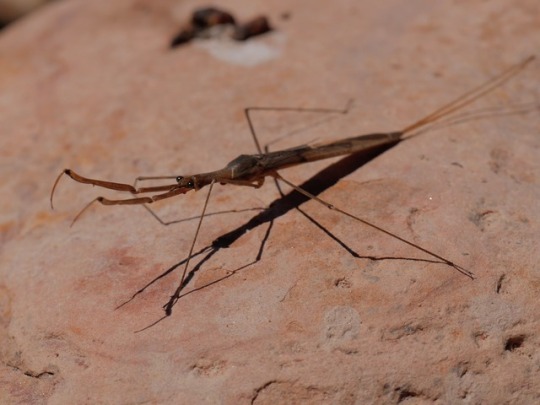
Ranatra fusca “Brown Waterscorpion” Nepidae
Lake Inez, Lolo National Forest, MT
May 23, 2017
Robert Niese
There’s something genuinely unnerving about insects viciously preying upon vertebrates, and waterscorpions are superbly specialized for this terrifying task. They sit near the surface of the water, head down, with their elongated, raptorial front limbs outstretched, waiting. Their long paired “tails” remain in contact with the water’s surface like a snorkel, allowing them to breathe while fully submerged. When some unlucky fish or tadpole swims too close, they snap them up like a mantis and immediately stab them with their sucking mouthparts. Their saliva both subdues and begins to digest their prey, allowing them to suck out the animal’s insides. On a completely unrelated note, this individual looks worse for wear, which led me to discover that adults actually overwinter in lakes and ponds here in Montana -- not an easy task considering that most bodies of water freeze-over completely at some point. So apparently they’re indestructible AND hyper-specialized predators. Thank goodness they’re only five inches long.
#Ranatra fusca#Ranatra#Nepidae#Waterscorpion#Brown Waterscorpion#Hemiptera#true bugs#Lake Inez#Lolo National Forest#Montana#Pacific Northwest#macro photography#original photography#photographers on tumblr#natural history#Robert Niese
90 notes
·
View notes